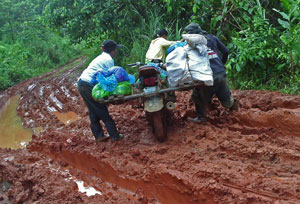Until 15 years ago, the possibility of a malaria-free Philippines seemed far-fetched. With an estimated 75,000 malaria cases yearly, malaria was one of the 10 leading causes of morbidity in the Philippines. At that time, almost 12 million people were at risk, particularly those who live in mountainous, remote and hard to reach areas where health services are also difficult to access.
Fast forward to 2012–malaria has been delisted from the top 10 leading causes of disease and death in the Philippines and 2020 has been set as the year for the disease to be eliminated as a public health problem.
The Philippines' Department of Health and the World Health Organization recognise Australia's contribution as instrumental in the fight against malaria in the Philippines. AusAID funded malaria activities in the country from 1995 to 2012–initially in the Agusan del Sur province and subsequently expanding to cover most provinces in Mindanao and other high-risk areas in the country through the Roll Back Malaria (RBM) program. Australia contributed approximately $13 million to prevent and eliminate malaria in the Philippines.
The RBM projects have been managed by the WHO Country Office in the Philippines in cooperation with the Philippine Department of Health and the National Malaria Program.
The RBM program used a 'bottom-up' approach of strengthening health systems in order to intensify malaria control in highly endemic and pre-elimination areas. This was done through 'The RBM Model'.
At the community level, the RBM Model delivered:
- skilled health workers
- effective, long-lasting insecticide-treated bed nets and selective indoor residual spraying
- early case detection and treatment
- prompt detection and management of outbreaks
- community mobilisation and school-based health promotion
- community outreach to remote and mobile populations
- enhanced surveillance from community to national level, including through the Philippines Malaria Information System (PhilMIS).
The results have been extraordinary. From 2007 to 2011, there was a 74.8 per cent reduction in reported malaria cases in RBM-supported provinces (from 11,829 to 2,978)–a greater and faster reduction than that reported from non-RBM provinces over the same period.
Deaths from malaria have been virtually eliminated nationally, falling by 92.3 per cent (from 26 deaths to 2) in RBM-supported provinces and 83.0 per cent in non-project provinces, between 2007 and 2011.
Some areas are verging on malaria elimination, while many other project-supported provinces meet the WHO threshold criteria to enter the pre-elimination phase.
The island province of Tawi-Tawi in the Autonomous Region of Muslim Mindanao lags behind other project areas, now contributing 70 per cent of all reported cases. This reflects the security problems and logistics challenges of delivering services in a politically unstable environment.
The RBM program in the Philippines has capitalised on an engaged society to build a sustainable, community-centred model of malaria control. This successful model has been replicated throughout the country by the national Program and local government counterparts.
Roll Back Malaria has changed the nature of the fight against malaria in the Philippines. With Australia's support, hundreds of thousands of people no longer live in the shadow of the disease.
The Philippine Government is well-placed to continue the gains made by the Australian-supported programs in combatting malaria and is now focussing on eliminating the disease by 2020. The campaign is supported by an increase in budget allocation for malaria–ffrom $1.7 million in 2008 to $4 million each year from 2009 to 2012–signifying the Philippine Government's own commitment to achieving a malaria-free Philippines.

